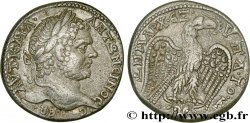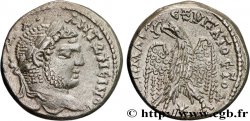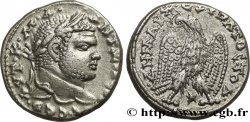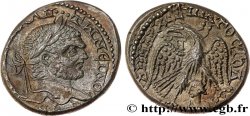bpv_173780 - CARACALLA Tétradrachme syro-phénicien
Not available.
Item sold on our e-shop
Price : 120.00 €
Item sold on our e-shop
Price : 120.00 €
Type : Tétradrachme syro-phénicien
Date: 215-217
Mint name / Town : Akko-Ptolemais, Phénicie
Metal : billon
Diameter : 25 mm
Orientation dies : 11 h.
Weight : 12,49 g.
Rarity : R1
Coments on the condition:
Pas de franche usure mais un très gros problème de corrosion
Catalogue references :
Obverse
Obverse description : Tête laurée de Caracalla à droite, l’un des deux rubans de la couronne laurée descendant sur l’épaule (O*).
Obverse legend : AUT K MA...ANTWNINOS .SEB. (Autokrator Kaisar Markos Aurhlios Antwneinos Sebastos)
Obverse translation : (L’empereur césar Marc Aurèle Antonin auguste).
Reverse
Reverse description : Aigle debout à gauche, les ailes déployées, la tête et la queue tournées à droite, couronne perlée dans le bec ; entre les pattes de l’aigle, Jupiter Héliopolitain de face, tenant un fouet dans une main et un foudre dans l’autre, à ses côtés des taureaux de face.
Reverse legend : DHMARC. EX. UPATOS TD. (Dhmarcikhs Exousias Upato to D)
Reverse translation : (Puissance tribunitienne, consul pour la quatrième fois).
Commentary
Si l’attribution de la série à l’idole de face et celle des Dioscures a été controversée, les deux opinions (Bellinger l’attribuant à Orthosia, Seyrig à Akko - Ptolemais) convergeaient pour lier ces deux séries. Les deux séries partagent trop de caractéristiques pour ne pas provenir de la même ville.
Rien d’étonnant à trouver deux symboles dans une même ville et plusieurs cités sont dans ce cas (Sidon et Carrhae par exemple).
L’hypothèse fiscale explique facilement cette situation : outre la cité, si celle-ci est effectivement une entité politique, comme groupement des familles et des corporations les plus importantes, il peut parfaitement se trouver d’autres institutions ou entités redevables de la taxe. Il semble peu probable que les temples aient été exemptés.
L’attribution à Akko - Ptolemais ne semble plus guère être contestée, la description faite par Seyrig de la statue cultuelle de Jupiter Héliopolitain correspondant très précisément à celle qui figure sur cette série : “Le dieu porte une cuirasse et un kalathos, lève un fouet de la main droite et un foudre de la main gauche. A ses pieds se trouve Hermès entouré de deux taureaux”.
On note que les sigma sont gravés en C.
Dans la base TSP maintenue par Michel Prieur, seize exemplaires sont maintenant répertoriés, trois en musée, deux à Paris, ex collection Seyrig, un à l’American Numismatic Society. Notre exemplaire est le 1216_014.
If the attribution of the series to the idol of the face and that of the Dioscuri was controversial, the two opinions (Bellinger attributing it to Orthosia, Seyrig to Akko - Ptolemais) converged to link these two series. The two series share too many characteristics not to come from the same city.
It is not surprising to find two symbols in the same city and several cities are in this case (Sidon and Carrhae for example).
The fiscal hypothesis easily explains this situation: besides the city, if it is indeed a political entity, as a grouping of the most important families and corporations, there may well be other institutions or entities liable for the tax.. It seems unlikely that temples were exempt.
The attribution to Akko - Ptolemais no longer seems to be contested, the description made by Seyrig of the cult statue of Jupiter Heliopolitan corresponding very precisely to that which appears in this series: “The god wears a breastplate and a kalathos, raises a whip in his right hand and a thunderbolt in his left hand. At his feet is Hermes surrounded by two bulls.”.
Note that the sigmas are engraved in C.
In the TSP database maintained by Michel Prieur, sixteen examples are now listed, three in museums, two in Paris, ex Seyrig collection, one at the American Numismatic Society. Our example is 1216_014
Rien d’étonnant à trouver deux symboles dans une même ville et plusieurs cités sont dans ce cas (Sidon et Carrhae par exemple).
L’hypothèse fiscale explique facilement cette situation : outre la cité, si celle-ci est effectivement une entité politique, comme groupement des familles et des corporations les plus importantes, il peut parfaitement se trouver d’autres institutions ou entités redevables de la taxe. Il semble peu probable que les temples aient été exemptés.
L’attribution à Akko - Ptolemais ne semble plus guère être contestée, la description faite par Seyrig de la statue cultuelle de Jupiter Héliopolitain correspondant très précisément à celle qui figure sur cette série : “Le dieu porte une cuirasse et un kalathos, lève un fouet de la main droite et un foudre de la main gauche. A ses pieds se trouve Hermès entouré de deux taureaux”.
On note que les sigma sont gravés en C.
Dans la base TSP maintenue par Michel Prieur, seize exemplaires sont maintenant répertoriés, trois en musée, deux à Paris, ex collection Seyrig, un à l’American Numismatic Society. Notre exemplaire est le 1216_014.
If the attribution of the series to the idol of the face and that of the Dioscuri was controversial, the two opinions (Bellinger attributing it to Orthosia, Seyrig to Akko - Ptolemais) converged to link these two series. The two series share too many characteristics not to come from the same city.
It is not surprising to find two symbols in the same city and several cities are in this case (Sidon and Carrhae for example).
The fiscal hypothesis easily explains this situation: besides the city, if it is indeed a political entity, as a grouping of the most important families and corporations, there may well be other institutions or entities liable for the tax.. It seems unlikely that temples were exempt.
The attribution to Akko - Ptolemais no longer seems to be contested, the description made by Seyrig of the cult statue of Jupiter Heliopolitan corresponding very precisely to that which appears in this series: “The god wears a breastplate and a kalathos, raises a whip in his right hand and a thunderbolt in his left hand. At his feet is Hermes surrounded by two bulls.”.
Note that the sigmas are engraved in C.
In the TSP database maintained by Michel Prieur, sixteen examples are now listed, three in museums, two in Paris, ex Seyrig collection, one at the American Numismatic Society. Our example is 1216_014








 Report a mistake
Report a mistake Print the page
Print the page Share my selection
Share my selection Ask a question
Ask a question Consign / sell
Consign / sell
 Full data
Full data









